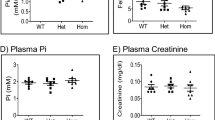Abstract
A two- to fourfold difference in the relative rate of total major urinary protein (MUP) synthesis between C57BL/6J and C3H/HeJ female mice has been analyzed at the genetic and molecular levels. The C57BL/6J phenotype is dominant in F1 female progeny of a cross between the two strains. Quantitation of MUP mRNA levels indicates that the rate of synthesis variation does not reflect a change in the concentration of total MUP mRNA. In recombinant inbred strains derived from C57BL/6J and C3H/HeJ progenitors, the rate of synthesis difference segregates as a single genetic determinant that is not linked to theMup-a locus on chromosome 4. The results suggest an unlinked locus that acts to alter total MUP synthesis without altering total MUP mRNA levels. Two models are proposed to describe the action of this locus, both of which imply some sort of posttranscriptional control of MUP synthesis.
Similar content being viewed by others
References
Alwine, J. C., Kemp, D. J., and Stark, G. R. (1977). Method for detection of specific RNAs in agarose gels by transfer to diazobenzyloxymethyl-paper and hybridization with DNA probes.Proc. Natl. Acad. Sci. USA 745350.
Bailey, D. W. (1971). Recombinant-inbred strains. An aid to finding identity, linkage, and function of histocompatibility and other genes.Transplantation 11325.
Bennett, K. L., Lalley, P. A., Barth, R. K., and Hastie, N. D. (1982). Mapping the structural genes coding for the major urinary proteins in the mouse: Combined use of recombinant inbred strains and somatic cell hybrids.Proc. Natl. Acad. Sci. USA 791220.
Berger, F. G., and Szoka, P. (1981). Biosynthesis of the major urinary proteins in mouse liver: A biochemical genetic study.Biochem. Genet. 191261.
Chapman, V. M., Paigen, K., Siracusa, L., and Womack, J. (1979). Biochemical variation: Mouse. In Altman, P. L., and Katz, D. D. (eds.),Inbred and Genetically Defined Strains of Laboratory Animals FASEB, Bethesda, Md., pp. 77–95.
Cox, R. A. (1968). The use of guanidinium chloride in the isolation of nucleic acids. In Colowick, S. P., and Kaplan, N. D. (eds.),Methods in Enzymology, Vol. XII Academic Press, New York, pp. 120–129.
Finlayson, J. S., Potter, M., and Runner, C. R. (1963). Electrophoretic variation and sex dimorphism of the major urinary protein complex in inbred mice: A new genetic marker.J. Natl. Cancer Inst. 3191.
Finlayson, J. S., Mushinski, J. F., Hudson, D. M., and Potter, M. (1968). Components of the major urinary protein complex of inbred mice: Separation and peptide mapping.Biochem. Genet. 2127.
Finlayson, J. S., Potter, M., Shinnick, C. S., and Smithies, O. (1974). Components of the major urinary complex in inbred mice: Determination of NH2-terminal sequences and comparison with homologous components from wild mice.Biochem. Genet. 11325.
Hastie, N. D., Held, W. A., and Toole, J. J. (1979). Multiple genes coding for the androgen-regulated major urinary proteins of the mouse.Cell 17449.
Hudson, D. M., Finlayson, J. S., and Potter, M. (1967). Linkage of one component of the major urinary protein complex of mice to the brown coat color locus.Genet. Res. Camb. 10195.
Knopf, J., and Held, W. A. (1981). The hormonal regulation of the major urinary protein synthesized in the mouse liver.Mouse News Lett. 6488.
Labarca, C., and Paigen, K. (1977). mRNA-directed synthesis of catalytically active mouse β-glucuronidase inXenopus oocytes.Proc. Natl. Acad. Sci. USA 744462.
Paigen, K. (1979). Acid hydrolases as models of genetic control.Annu. Rev. Genet. 13417.
Rigby, P. W., Dieckmann, M., Rhodes, C., and Berg, P. (1977). Labelling deoxyribonuleic acid to high specific activityin vitro by nick translation with DNA polymerase I.J. Mol. Biol. 113237.
Szoka, P. R., and Paigen, K. (1978). Regulation of mouse major urinary protein production by theMup-a gene.Genetics 90597.
Szoka, P. R., Gallagher, J. F., and Held, W. A. (1980).In vitro synthesis and characterization of precursors to the mouse major urinary proteins.J. Biol. Chem. 2551367.
Watson, J., Riblet, R., and Taylor, B. A. (1977). The response of recombinant inbred strains of mice to bacterial lipopolysaccharides.J. Immunol. 1182088.
Weatherall, D. J., and Clegg, J. B. (1979). Recent developments in the molecular genetics of human hemoglobin.Cell 16467.
Author information
Authors and Affiliations
Additional information
This work was supported in part by Grant GM19521 from the United States Public Health Service.
Rights and permissions
About this article
Cite this article
Berger, F.G. Studies on genetic variation in major urinary protein synthesis in mouse liver. Biochem Genet 21, 15–23 (1983). https://doi.org/10.1007/BF02395388
Received:
Revised:
Issue Date:
DOI: https://doi.org/10.1007/BF02395388




